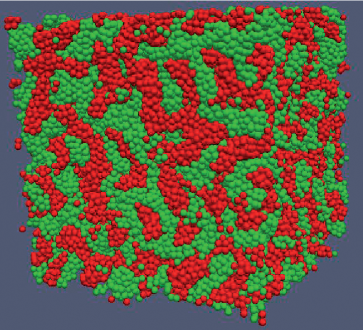MULTISCALE MODELING IN BIOLOGY
A hallmark of living systems is their multiscale nature – their structure and behavior, in time and space, functions on multiple scales of biological organization. Furthermore, these scales are interlinked in that system behaviors on one scale influence and constrain behaviors on another scale. Consider that individual cells are themselves complex systems of molecular interactions that comprise networks among nucleic acids, proteins, lipids, metabolites, and other biomolecules. Cells process information from their environment, make decisions in response to that information, and exhibit complex behaviors. In multicellular organisms, cells do not function independently. Rather, they interact and communicate physically and chemically as they move, adhere, divide, or secrete and uptake diffusible molecules.
Complex structures involving billions of cells emerge from such interactions, such as networks of blood vessels in healthy or diseased tissues. Such structures impact the system at a “higher” scale – for example, by supplying blood to the growing tumor more efficiently, promoting cellular growth or immune infiltration. Importantly, these emergent structures, which themselves are products of intercellular and intracellular interactions, influence the “lower” scales by causing cells to alter the states of their intracellular molecular networks. These different states in turn affect cellular behaviors, such as cell division, programmed cell death, or motility.
LINKING THE SCALES FOR PREDICTION AND CONTROL
Although the molecular and multicellular scales are interlinked, it is important to recognize that we may very well wish to be able to predict and control the system at different scales of interest. For example, on the multicellular or tissue scale, we may wish to predict a general property of a vascular network in a tumor, such as the spatial distribution of perivascular tumor cells, potentiating metastasis or the expected distribution of blood flow to the tumor. At the same time, the control of the system occurs at the lower molecular scale. This may be achieved by chemically inhibiting one or more specific molecular interactions, leading to a reduction of vascular growth or cellular motility.
MULTISCALE MODELS FOR CANCER AND DIGITAL TWINS
Cancer research requires multiscale modeling. The enormous power and success of the genomic and molecular paradigm of cancer has made it possible to comprehensively measure genomic, transcriptional, proteomic, and epigenomic information in multiple cancers. This underpins our understanding of how molecular systems in cancer cells are disrupted and is a central goal of large-scale cancer genomics projects, such as The Cancer Genome Atlas (TCGA). Further efforts such as the Pan-Cancer Atlas, only strengthened the emerging consensus that the tumor microenvironment plays a crucial role in cancer onset and progression. This requires the integration of vast amounts of information on the molecular and cellular scales, such as the Human Tumor Atlas Network, into multiscale models that could be used to develop personalized therapies for cancer patients.
Such personalized dynamic models culminate in so-called “digital twins” for cancer patients. What makes digital twins different from just models is not only their personalization for each patient, but the dynamic updating of the model in light of longitudinal measurements and clinical data obtained from the patient, representing the patient’s disease trajectory over time. Digital twins can be used to forecast the disease progression, response to interventions, such as drugs, and adverse events associated with interventions.
Publications:
R. Laubenbacher, F. Adler, G. An, F. Castiglione, S. Eubank, L. L. Fonseca, J. Glazier, T. Helikar, M. Jett-Tilton, D. Kirschner, P. Macklin, B. Mehrad, B. Moore, V. Pasour, I. Shmulevich, A. Smith, I. Voigt, T. E. Yankeelov, T. Ziemssen, “Forum on immune digital twins: a meeting report,” npj Systems Biology and Applications, Vol. 10, No. 19, 2024.
Y. Zhang, G. Qin, B. Aguilar, N. Rappaport, J. Yurkovich, L. Pflieger, S. Huang, L. Hood, I. Shmulevich, “A framework towards digital twins for type 2 diabetes,” Frontiers in Digital Health, Vol. 6, 2024.
E. A. Stahlberg, M. Abdel-Rahman, B. Aguilar, A. Asadpoure, R. A. Beckman, L. L. Borkon, J. Bryan, C. Cebulla, Y. H. Chang, A. Chatterjee, J. Deng, S. Dolatshahi, O. Gevaert, E. J. Greenspan, W. Hao, T. Hernandez-Boussard, P. R. Jackson, M. Kuijjer, A. Lee, P. Macklin, S. Madhavan, M. D. McCoy, N. M. Mirzaei, T. Razzaghi, H. Rocha, L. Shahriyari, I. Shmulevich, D. G. Stover, Y. Sun, T. Syeda-Mahmood, J. Wang, Q. Wang, and I. Zervantonakis, “Exploring approaches for Predictive cancer patient digital twins: Opportunities for collaboration and Innovation,” Frontiers in Digital Health, vol. 4, 2022.
T. Hernandez-Boussard, P. Macklin, E. J. Greenspan, A. L. Gryshuk, E. Stahlberg, T. Syeda-Mahmood, I. Shmulevich, “Digital Twins for predictive oncology will be a paradigm shift for precision cancer care,” Nature Medicine, (PMID: 34824458), 2021.
B. Aguilar, D. L. Gibbs, D. L. Reiss, M. McConnell, S. A. Danziger, A. Dervan, M. Trotter, D. Bassett, R. Hershberg, A. V. Ratushny, I. Shmulevich, “A generalizable data-driven multicellular model of pancreatic ductal adenocarcinoma,” GigaScience, Vol. 9, No. 7, giaa075, 2020.
R. Tasseff, B. Aguilar, S. Kahan, S. Kang, C. C. Bascom, R. J. Isfort, “An integrated multiscale, multicellular skin model,” bioRxiv, 10.1101/830711, 2019.
B. Aguilar, A. Ghaffarizadeh, C. D. Johnson, G. J. Podgorski, I. Shmulevich, N. S. Flann, “Cell death as a trigger for morphogenesis,” PLoS ONE Vol. 13, No. 3, e0191089, 2018.
S. Kang, S. Kahan, J. McDermott, N. Flann, I. Shmulevich, “Biocellion: Accelerating Computer Simulation of Multicellular Biological System Models,” Bioinformatics, Vol. 30, No. 21, pp. 3101-3108, 2014.



 shmulevich.isbscience.org/research/multiscale-modeling/
shmulevich.isbscience.org/research/multiscale-modeling/